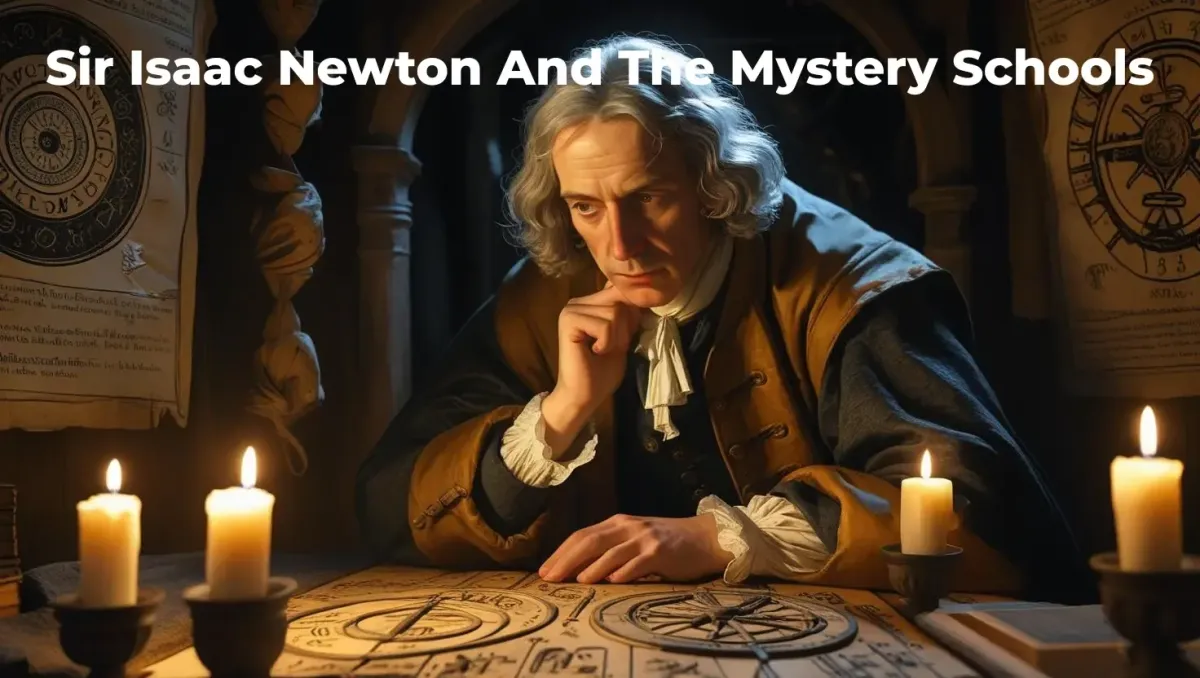
Sir Isaac Newton, Alchemy, and the Hermetic Tradition
Sir Isaac Newton (1642–1727) is often remembered as the father of modern science — the man who defined the laws of motion, discovered universal gravitation, and pioneered calculus. Yet beneath this towering scientific legacy lies a lesser-known truth: Newton was also deeply immersed in alchemy and Hermetic philosophy.
In fact, he wrote more on alchemy than on physics, filling notebooks with experiments, translations, and esoteric reflections. For Newton, the quest for knowledge was not limited to the material world but extended into the mystery school tradition of hidden wisdom — the pursuit of unity, transformation, and divine order.
New to mystery schools? Start with our overview article “What Are Mystery Schools?” and then visit the Mystery School hub for classes, courses and next steps.

Newton the Seeker Beyond Science
To Newton, science was not a closed system of empirical laws. It was a spiritual quest, an attempt to uncover the divine architecture of creation. Like John Dee before him (John Dee: Hidden Knowledge of the Renaissance Mystery Schools), Newton believed that mathematics, alchemy, and scripture were complementary languages of truth.
He once wrote:
“The world is a cryptogram set by the Almighty.”
This conviction echoes the mystery schools, which taught that nature was a living text, filled with symbols awaiting interpretation.
For a broader view of this lineage, see What Are Mystery Schools? The Hidden Lineage of Ancient Wisdom.
Newton and Alchemy
Alchemy was central to Newton’s intellectual life. He collected over a million words of notes on alchemical texts, many of which remained unpublished until long after his death.
He experimented with furnaces and crucibles, seeking to understand transformation at the material level.
He studied the Emerald Tablet of Hermes Trismegistus (The Emerald Tablets & Hermes Trismegistus: Foundations of Mystery School Wisdom), pondering its maxim “As above, so below.”
He pursued the elusive Philosopher’s Stone, not merely as a literal substance but as a symbol of spiritual perfection.
Alchemy, for Newton, was not a superstition but a profound science of change — both inner and outer.
Hermetic Philosophy and the Cosmos
Newton’s worldview was deeply coloured by Hermetic principles (The Hermetic Principles: Universal Laws of the Mystery Schools). He believed that the universe was an interconnected whole, animated by divine intelligence.
Gravity itself, in Newton’s imagination, was a mystical force of attraction — a hidden thread binding all things together.
His studies of light and optics reflected Hermetic fascination with illumination, both physical and spiritual.
His biblical writings reveal a mind searching for hidden codes that linked history, prophecy, and cosmic cycles.
For Newton, Hermeticism was not opposed to science but its deepest foundation.
Newton’s Secret Studies
Because alchemy was frowned upon by the Royal Society and orthodox religion, Newton kept much of his esoteric work hidden. He used coded language in his notebooks and circulated translations of alchemical texts privately.
Some scholars argue that Newton’s breakthroughs in physics were fuelled by his alchemical imagination — his vision of invisible forces shaping the material world. Without alchemy, they suggest, Newton might not have conceived of universal gravitation.
For a similar weaving of science and mysticism, see Albert Einstein and Esoteric Wisdom: How Mystery Schools Shaped His Vision.
Newton and Prophecy
In addition to alchemy, Newton was fascinated by biblical prophecy and Kabbalah. He studied the Book of Revelation, trying to calculate the end of the world and the coming of a new age. His notes show deep engagement with esoteric timelines, echoing mystery school teachings of cosmic cycles.
This prophetic vision reflects Newton’s belief that history itself was governed by divine laws — another parallel to the Hermetic view of universal principles.
The Philosopher’s Stone as Inner Transformation
While many sought alchemy’s secrets to produce gold, Newton seems to have understood the Philosopher’s Stone in more symbolic terms. For him, the Stone represented the perfection of matter and spirit, a union of opposites that reflected the mind of God.
This mirrors the mystery school tradition of inner alchemy, where spiritual refinement was seen as the true “gold.”
See Alchemy and the Mystery Schools: The Inner Gold of Transformation.
Newton’s Legacy in Esotericism and Science
Newton’s esoteric pursuits shaped both his scientific method and his spiritual worldview. His legacy includes:
Science grounded in mysticism — Newton saw natural laws as divine revelations.
Alchemy as inspiration — His search for hidden forces encouraged breakthroughs in physics.
Hermetic influence — He carried forward the ancient mystery school vision of a unified cosmos.
A bridge for future traditions — From Rosicrucians to modern esotericists, Newton is remembered as both scientist and sage.
His life shows that the great minds of history often drew from mystery school currents, where wisdom is holistic, symbolic, and transformative.
Next Steps on your Mystery School Path
If this article spoke to you, don’t leave it as just an interesting idea. Take one gentle step to deepen the journey.
·Visit the Mystery School hub to see all classes and courses in one place.
·Explore the 7 Hermetic Principles for a structured, step-by-step dive into this lineage.
Continue reading with these related articles:
Alchemy and the Mystery Schools: The Inner Gold of Transformation
Albert Einstein and Esoteric Wisdom: How Mystery Schools Shaped His Vision
Choose the one that feels kindest and most alive for you right now, and let the work unfold at your own pace.

Explore Newton’s Hermetic Legacy
Isaac Newton was not only a scientist of the highest order but a seeker of hidden truths. His blend of alchemy, Hermetic philosophy, and science reflects the enduring influence of the mystery schools.
At the Bright Beings Academy Mystery School, we explore the same traditions that inspired Newton — from alchemy to sacred geometry and Hermetic wisdom.

FAQs on Sir Isaac Newton and the Mystery Schools
Did Isaac Newton really practise alchemy?
Yes. He left extensive notes on alchemical texts, experiments, and translations — more than on physics.
Why did Newton hide his alchemical work?
Because alchemy was considered heretical and unscientific by his contemporaries. He feared damaging his reputation.
How do Hermetic principles relate to Newton’s science?
Hermetic ideas of unity, hidden forces, and cosmic harmony influenced Newton’s conception of gravitation, light, and natural law.
Was Newton influenced by mystery schools?
Yes. Through Hermetic, alchemical, and Kabbalistic texts, Newton absorbed teachings central to the mystery school tradition.
I look forward to connecting with you in my next post.
Until then, be well and keep shining.
Peter. :)
